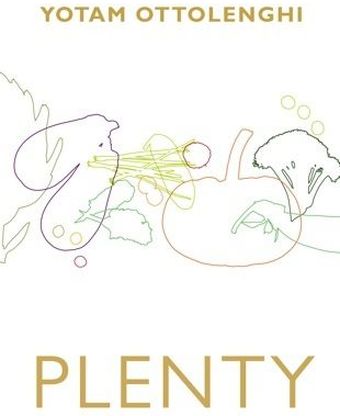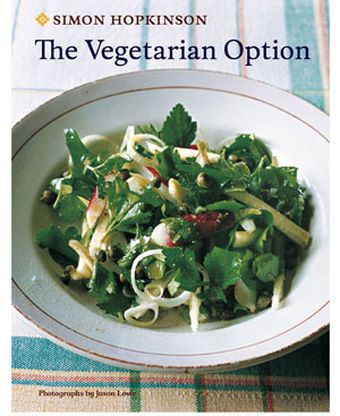Two vegetarian cookbooks from non-vegetarians: this is good, almost a guarantee that you won’t be confronting a ton of tasteless tofu and ropey chick pea recipes with headnotes that tell you how terrific such ingredients can be, a quality often left in doubt when recipe-meets-mouth.
Both books are from England from writers I admire. Simon Hopkinson wrote the engaging Roast Chicken And Other Stories which won my heart because it was mostly prose with no -- underline that no --unduplicatable food stylist-assisted photos. In this it was a throwback to marvelous books with an authorial feel like Elizabeth David’s or Richard Olney’s. The writing made me hungry. My bet is that books that are more literary, rather than visual, will not be replaced by internet recipe collections. When you can get good pictures, good recipes, and even videos from a trusted site (e.g. this one), the era of expensively photographed, gushingly essayistic cookbooks (my own included) may have reached their zenith with only one way to go. Books like Hopkinson’s, on the other hand, are personal statements and, as such, I think they have a future, even in the Digital Holocaust.
Yotam Ottolenghi -- how could such a Dr Seuss-like name not raise a smile? -- has built a string of Silver Palate-like businesses in London, along with Sami Tamimi. Ottolenghi, an Israeli Jew by birth, and Tamimi, a Palestinian Arab, share an affection for bold, bright Mediterranean flavors that comes through in Plenty, a volume of unusual recipes which, for the most part, work beautifully. This is less than surprising given that Ottolenghi has written a vegetarian column for the Guardian for the last decade: i.e. the recipes are drawn from a large reservoir and have gone out in the world to run the gauntlet of reader responses and, I am guessing, corrections, before finding their way between the covers of a book. Those covers tell you instantly that here is a book that is light in spirit. Padded yet not puffy, with playful colorful line drawings, it carries none of the gravitas of a bench-pressable Adria or Blumenthal tome.
I often say -- and still believe, though I was gently taken to task for it at last year’s Piglet party -- that if you add one recipe to your repertoire from any cookbook, then it is worth the price. By that measure, these are both worthwhile efforts. In The Vegetarian Option, Hopkinson’s Baked Stuffed Tomatoes-Paella Style delivers powerhouse flavor and, with its bracing, saffron-infused rice and peppery heat, it is a satisfying main course or even a light meal. The directions do not tell you to check that the rice has enough liquid to cook through, but instead asumes you know to add more a few times during cooking. Oh well. All recipes are roadmaps and need to adjust to the ingredients you have in your larder rather than the ones the author used.
I loved that paella-ish tomato almost as much as the Sweet Corn Polenta in Ottolenghi. Take the term “polenta” under advisement. Actually it’s a puree of cooked, freshly picked sweet corn that is reduced to the thickness of regular polenta and enriched with feta cheese and butter. The sauce of eggplant, tomatoes and wine is heavenly and would work just as well with pasta. I made this dish three times for three different groups and the result was always a collective wow.
Ottolenghi’s take on socca is tremendously flavorful. While working my way through it I thought that roasted cherry tomatoes on top of wilted onions with thyme, finished with vinegar, was a good idea but nothing special. Then I tasted the combo. Supernal! As for the socca, I find making it in separate little crepes more work than it’s worth. I’ll stay with Mark Bittman’s bigger, easier socca. That said, the roast tomatoes, onions and thyme make this recipe a standout.
My wife, Melinda, and a friend were intrigued by Ottalenghi’s Crusted Pumpkin Wedges with Soured Cream. As a writer I don’t like neologisms such as soured cream. Is that the norm in Britain? To me, it’s what Lenny Bruce used to call "showy Yiddish British." Maybe they’ll change it to Sour Cream in the American edition. Then there’s the issue of Pumpkin. As a graduate of Princeton, I know how useless Orange and Black is as a design or clothing motif. It’s good one day a year. I feel pretty much the same way about pumpkins. But the recipe intrigued Melinda, and the farm stand had plenty of pumpkins so we tried. It was kind of a bust. The pumpkin needed more cooking -- lots more -- than called for and, in the end, it would have been too much work even if it had turned out better.
The cover of The Vegetarian Option features a Parsley, Radish, and Celery Salad with capers. Believing that you should be able to judge a cookbook, or at least form an opinion, by what’s on the cover, I made it. I have grown fond of such lettuce-less salads ever since Fergus Henderson’s Parsley Onion Caper thing with roast marrow bones, and more recently the Franks (of Frankies and Prime Meats) have rung great changes on the St. John classic. To that list you may add Hopkinson’s invention. “Simple, fragrant, sharp, and crisp,” he writes, with admirable economy.
Judging these books by the best recipes in them, I am left inclining toward one, but not by all that much. But then there are the rest of the recipes. Too much of Hopkinson’s book falls in the “why bother to tell this tale yet again?” category. Macaroni and Cheese With Tomatoes? Didn’t we already know about that? Or Spaghetti with Aglio and Pepperoncino? Or Caesar Salad?
The winner, Plenty.



1 Comment